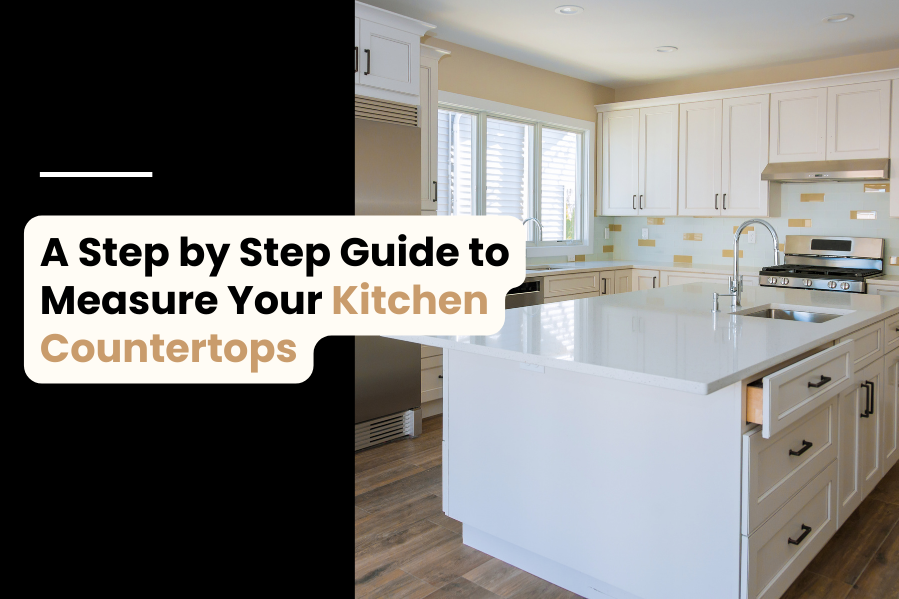What is the Standard Height for Kitchen Countertops?
When you are renovating your kitchen, the height and depth of the countertops may not be the first thing on your mind. However, they are super important. Think about it: You want your kitchen to be comfy and easy to use, right? That's where knowing the standard measurements for countertops comes in handy. These surfaces are not just workspaces but also define the overall design of the kitchen.
In this guide, we will discuss the standard height for kitchen countertops, how they affect your kitchen's design, and how they make it easy to work in your kitchen.
What is the Average Height for Kitchen Countertops?
Countertops are essential workspaces for everything from chopping veggies to setting up your coffee maker. So, what is the right height for this essential element?
The standard height for a kitchen countertop is about 36 inches. This measurement includes a 34.5-inch-high base and a countertop material that's usually around 1.5 inches thick. However, keep in mind that these measurements are based on the average user's height. Ideally, countertops should sit around 3 to 8 inches below the average elbow height to make tasks like chopping and cooking more comfortable.
A Step by Step Guide to Measure Your Kitchen Countertops
Now, let's see how you can accurately measure your kitchen countertops. Follow the below steps to measure the kitchen countertops. It will make your renovation plan easier.
Things You'll Need:
Pen
Paper
A tape measure
Calculator
Step 1: Make a rough sketch
Sketch a rough diagram of your countertop area, including any islands or backsplashes. Mark the placement of sinks and appliances. Divide the countertop into rectangular sections for more straightforward measurement. Even if you have rounded or oval-shaped islands, treat them as squares for ease.
Step 2: Measure the Length
Now, measure the length of each countertop section and note down the measurements.
Step 3: Calculate the Width
Measure the width of each countertop section and record the measurements.
Step 4: Make the Calculations
For each section, multiply the length by the width to find the square footage. Keep track of these calculations in your diagram.
Step 5: Find the Total Area
Add up the square footage of all the sections to find the total area in square inches. Since suppliers usually quote prices in square feet, you'll need to convert the area. Divide the total square inches by 144 to get the total area in square feet.
Factors Influencing Standard Countertop Height and Depth
When you are designing a kitchen, various factors determine the standard height and depth of countertops. These factors ensure your kitchen's functionality, comfort, and aesthetic appeal. So, let's discuss them.
1. Kitchen Cabinet Dimensions
Standard countertop heights are often based on the average heights of individuals, which helps maintain affordability in projects. For instance, in the United States, the typical height of an average man is 5'9", and for women, it is 5'4". Additionally, standard countertop depths range from 24 to 25.5 inches, which ensures they are compatible with kitchen cabinets.
2. Appliance Integration
Countertop dimensions must align with the size and installation requirements of kitchen appliances like dishwashers, cooktops, refrigerators, and ovens. Mismatched heights or depths can disrupt workspace flow and hinder functionality.
3. Style and Design
Countertop thickness and material choices influence the overall design and ambiance of the kitchen. Thicker countertops give a luxurious look, while thinner ones offer a modern aesthetic. Balancing design goals with practical considerations ensures cohesion and visual appeal.
4. Elbow Height & Countertop Purpose
One way to measure the ideal countertop height(s) is to calculate the distance between your elbow and the floor. Here's a breakdown of ideal countertop heights for different tasks:
Aim for countertops that sit approximately 3-4 inches below your elbow for food prep. This position will make it easier to chop, slice, and prepare ingredients. So, ultimately, it will prevent strain on your arms and shoulders.
Countertops about 5-6 inches below your elbow are ideal cooking surfaces. This height ensures comfortable working conditions and reduces the risk of oil splashing onto your face during cooking.
A countertop 8 inches below your elbow is the perfect working area for bakers. They spend a lot of time rolling dough and kneading bread. This lower height facilitates baking activities. It will not cause undue strain on your arms or back.
5. Physical Needs
The countertop height should accommodate different physical needs. For example, it should be accessible to individuals with disabilities or specific preferences. A standard height of 34 inches suits most wheelchairs. However, there could be any adjustments for taller or shorter users. Considering ergonomic principles ensures comfort during kitchen activities.
Common Misunderstandings About Counter Height
Here are some common misconceptions about counter height. Let’s address these misconceptions to clarify important aspects of kitchen design. Here are two key points to consider:
Countertop and Bar Stool Height
There is a difference between countertop height and bar stool height. Countertop height refers to the surface level of the counter itself. At the same time, bar stool height is made to fit the height of stools used at a bar counter. These heights can vary.
So, select a bar stool that matches the specific counter height for comfortable seating. Confusing the two measurements can lead to discomfort and awkward seating arrangements.
Counter Height's Influence on Posture
Do you also believe that counter height influences an individual's posture? Counter height is an important factor in ergonomics. However, it alone does not guarantee good posture. Maintaining proper posture, such as standing or sitting with a straight back, relaxed shoulders, and neutral spine alignment, depends on the user. So, while it's helpful to have the counter at the right height, you still need to pay attention to your standing or sitting position to avoid discomfort or strain.
Are You Ready for Your Kitchen Remodel?
If you are considering a kitchen remodel, there is no better option than Cascella and Sons Construction. We are Long Island's premier home improvement experts with over 35 years of experience in the construction industry. At Cascella and Sons Construction, we pride ourselves on delivering quality through our wealth of knowledge. We ensure that every project we undertake exceeds our clients' expectations.
Our comprehensive range of home improvement services includes roofing, siding, decks, porches, kitchen and bathroom remodeling, and much more. What makes us stand out is our personalized approach. We understand that every home is different, so we tailor each project to fit your specific requirements and preferences.
Let’s Recap
So here comes the end of our today's discussion. It is essential to understand the height of your kitchen countertops correctly. It ensures a comfy and practical kitchen. When you know the standard measurements, it helps in making your kitchen user-friendly. When you are designing your kitchen countertop, make sure you consider factors like cabinet dimensions, appliance sizes, and height. In the end, when you are designing your kitchen, consult a professional contractor for helpful guidance.


